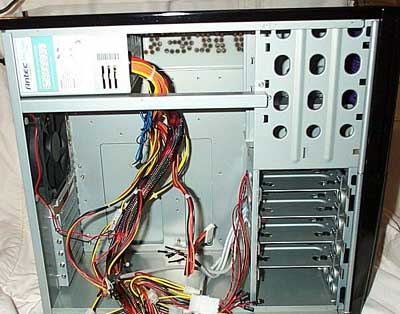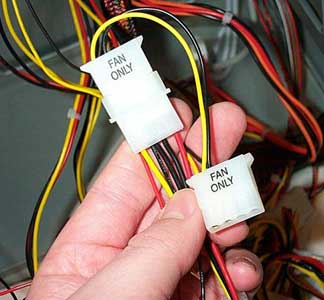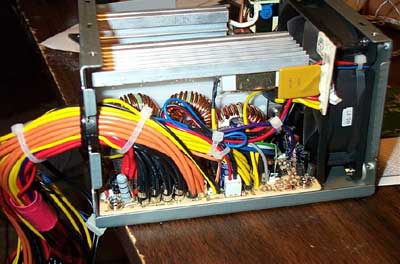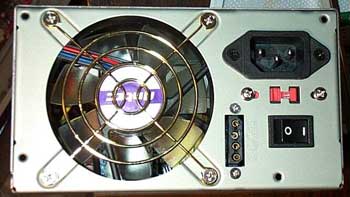|
|
|
|
 Antec Sonata Case Review Antec Sonata Case Review
|
|
Date Posted: Apr 10 2003
|
|
Author: pHaestus
|
|
|
|
|
Posting Type: Review
|
|
Category: Case Reviews
|
|
Page: 1 of 2
|
|
Article Rank:No Rank Yet
Must Log In to Rank This Article
|
|
|
|
|
Note: This is a legacy article, imported from old code. Due to this some items on the page may not function as expected. Links, Colors, and some images may not be set correctly.
|
|
|
Antec Sonata Case Review By: pHaestus
|
|
Antec Sonata Case Review
By: pHaestus 4/10/03
|
|
As transistor count and heat of PC components increases, so too does the cooling needed to keep them within specified operational limits.
For the majority of the PC world, this means increased system noise as a result of higher airflow requirements. We who water cool have been computing in blissful silence for years (thanks to low speed fans on large radiators), but the rest of the PC world has not been so fortunate. The overclocking nut running 60 dBA Delta EHEs is an extreme example, but even mainstream systems are sometimes quite noisy. Silencing noisy PCs is an emerging theme of several enthusiast websites (http://www.silentpcreview.com is a popular one), targeted webstores (http://www.lownoise.de , www.quietpc.com ), and a popular topic in many online forums. In fact, I overheard a conversation on the topic in the Toronto airport this week between what appeared to be two normal PC users (middle-aged men). One of the guys had just bought a new AMD system locally, and couldn't stand the noise level (he was a former Mac user). He was telling the other guy about going to the web and finding all these pages on using carpeted boxes and noise dampening materials and rubber grommets and special fans to make the system silent. These guys didn't strike me as the blowhole or cold cathode types, but they were discussing case modifications.
Manufacturers haven't missed out on the buzz concerning quiet PCs either. Over the last year, the number of "silent" and "quiet" fans and psus has
skyrocketed.
And thermally-controlled fan speed adjustment is becoming quite common as well. Motherboard manufacturers seem to finally be implementing the PWM fan control of the winbond IC (Speedfan users rejoice!), and products like the CrystalFontz 633 make temperature dependent fan speed setup simple. For manual fan control, there have to be at least a dozen inexpensive 5.25" and 3.5" bay fan controllers with knobs and leds on the market now. I remember soldering together a LM317-based unit from scratch not too long ago, but now that they are mass produced, I can purchase them for less money than it would cost to build one.
It was only a matter of time before a mainstream case manufacturer came out with an enclosure targeted at those seeking silent computers. A few companies
(Koolance and Swiftech) have tried to push water cooling in this way, but the initial cost and the potential for problems scares off many average quiet PC users. Antec, Inc (www.antec-inc.com) is to my knowledge the first company to release a
PC enclosure that is designed and marketed to those seeking silence. Today, we will be taking a close look at that case, the Antec Sonata.
|
|
|
Dimensions
|
16.75"(H) x 18.25"(D) x 8.13"(W)
|
|
5.25 bays
|
3
|
|
3.5 bays
|
2 external
4 internal
|
|
drive rails
|
yes
|
|
Removable mobo tray
|
No
|
|
Construction
|
1mm steel
|
|
Power Supply
|
TruePower 380W
|
|
Cooling
|
120mm exhaust (included)
120mm intake (optional)
|
|
Media ports
|
sound, mic, audio in
|
|
|
1x firewire, 2x USB
|
|
Security
|
Locking front door and
|
|
|
side panels
|
|
Other
|
Grommet-mounting of hdds and fans for noise reduction, Fan intake filters, Side door handle.
|
|
|
The Sonata is a somewhat small midtower that is fairly comparable to the Antec SX635 in terms of its size. Here are the general specifications:
What is probably of more interest to you guys are the special noise reduction features. All the HDDs are mounted on removable trays that have grommets to
dampen noise from HDD vibration,. The case fans are held on the case by rubber grommets as well so they do not cause any vibrational noise. And to further lower fan noise, the Truepower 380W PSU has special Molex
connectors for case fans that lower their voltage to further quiet the fans. To compensate for any loss in cooling at reduced voltage, Antec opted for 120mm case fans for the Sonata. This is certainly a welcome change..
|
|
|
Initial thoughts and appearance
|
|
When I first unpacked the Sonata, I noticed two things immediately: (i) it is made of steel and so it is noticeably heavier than the many aluminum cases
littering my house and (ii) it is SHINY!
Antec calls the finish piano black, and with good reason. The side panels and top have an automotive-style black finish on them rather than the matte powder coating that Antec used in the past. I thought the effect was very nice and gave the enclosure a classy look.
|
|
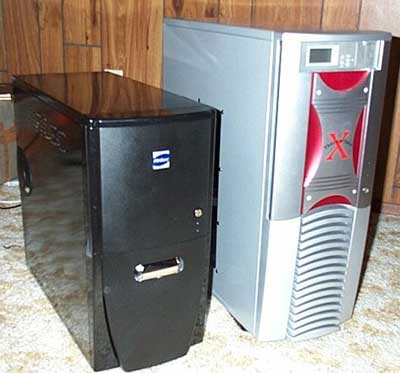 |
|
|
Sonata next to another Antec clone. Note the shiny paint!
One thing about the panels that will turn some of you off is the fact that the top, bottom, and one side of the case are all one piece and riveted
into place.
Now this isn't a huge deal because the drive bays all have drive rails so there is no pressing need to get to those sides of the case. However, I personally cut a hole in motherboard trays under the CPU to gain access to the 4 socket holes. This is not really feasible with the Sonata, so if you are a "backwards waterblock spring mounting" kinda guy then be aware.
|
|
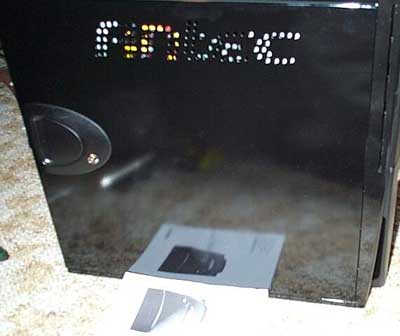 |
|
|
I have owned two Antec cases previously, and the Sonata shares many of the design features with the older SX series of cases. The excellent door handle
mechanism is still present in the Sonata, as is the locking front door. However, some aspects of the case are completely new.
For example, the front bezel was substantially redesigned on the Sonata to give it a much cleaner and distinctive look.
|
|
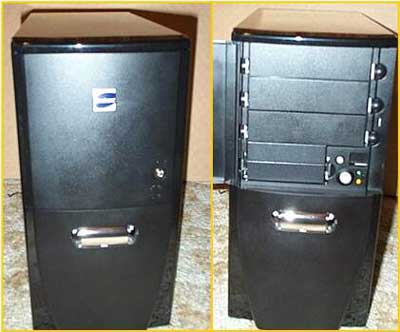 |
|
|
|
|
|
|
|
|
The end result of the new paint job and bezel was an extremely clean and attractive case. One thing that may turn some readers off is the "Antec" logo
punched into the side panel, The holes are designed to aid in cooling, but the design is a little on the gaudy side for my tastes.
Another thing that one notices about the front of the case is the shiny silver piece. That piece is actually a door for the multimedia ports.
On either side of this door are blue LEDs. They are not the high intensity "wake the neighbors" versions and I don't find them too obtrusive. Antec wired the LEDs to a normal 4 pin molex (they are 5V), so if you don't care for them then you can just unplug them at any time.
|
|
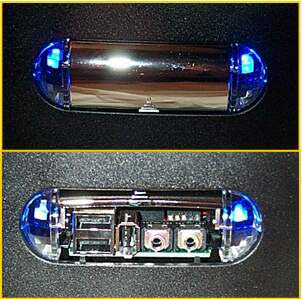 |
|
|
The standout feature of the Sonata when it is opened is the sideways mounted HDD area.
I honestly don't know why no one has done this before, as it seems a much more efficient use of space. A side effect of this layout is that the intake fan (which is optional and not part of the package) is placed inside the case rather than mounted directly on the front. This will also help to lower noise because the fan will be muffled by the Sonata's thick steel panels.
|
|
|
|
In my past reviews of Antec cases, I have had two complaints.
One was that they used 80mm fans, and the other was the lack of a filter for the intakes. I am happy to report that the Sonata has both 120mm fans and a filtered intake. Right away, my opinion of the case was very positive because I felt that Antec had actually been listening to reviews I had written in the past. Never mind the hundreds of people saying the same thing in forums, this is my moment in the sun :)
|
|
|
|
|
|
|
|
Power Supply
A case with an included power supply is a nice change of pace after using Lian Li cases for a year or so. Antec includes the 380W TruePower PSU with the
Sonata because it is specially designed for low noise applications.
While most manufacturers have switched to 2,3 or even 4 fans in their PSU, Antec instead opted for only a single 80mm exhaust fan to keep noise levels down. Another noise reduction measure is the addition of a fan connector wire for case fan adjustment.
|
|
|
|
|
The PSU will automatically adjust the fan voltage, presumably as PSU load increases, to keep noise levels down when the system is not under stress. I
couldn't find any details of how this is done, so I cracked open the Antec PSU to take a closer look.
|
|
|
|
The voltage controller is in the little box affixed to the heatsink.
I am not sure if this is measuring the heatsink temperature and adjusting fan voltage accordingly or if the heatsink is cooling a voltage regulator in the box. I couldn't detect a noticeable change in fan noise from idle to load, so I couldn't tell that the "fan speed control" was actually doing much. It does keep the fans inside the case very very quiet though. I also looked around inside for potentiometers to adjust the 5V rail while I had the PSU open. None were to be found. One other thing about the Antec PSU stood out: it has a molex connector on the back of the psu!
|
|
|
|
|
|
|
|
This may seem useless to some, but I know a person or two who has a powerstrip modified with a 12V relay to turn on pump and peltier psu only when
the system is running. This molex connector would be perfect for that. It also is very handy for people who want to test out a fan or other device externally.
|
|
|
|
|
| Random Forum Pic |
 |
| From Thread: Need some socket A design assistance... |
|
| | ProCooling Poll: |
| So why the hell not? |
|
I agree!
|
 67% 67%
|
|
What?
|
 17% 17%
|
|
Hell NO!
|
 0% 0%
|
|
Worst Poll Ever.
|
 17% 17%
|
Total Votes:18Please Login to Vote!
|
|






 Antec Sonata Case Review
Antec Sonata Case Review




